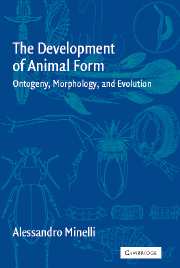Book contents
- Frontmatter
- Contents
- Preface
- Acknowledgements
- 1 The Nature of Development
- 2 Everything Begun to the Service of Development: Cellular Darwinism and the Origin of Animal Form
- 3 Development: Generic to Genetic
- 4 Periodisation
- 5 Body Regions: Their Boundaries and Complexity
- 6 Differentiation and Patterning
- 7 Size Factors
- 8 Axes and Symmetries
- 9 Segments
- 10 Evo-devo Perspectives on Homology
- Summary and Conclusions
- References
- Index
6 - Differentiation and Patterning
Published online by Cambridge University Press: 10 August 2009
- Frontmatter
- Contents
- Preface
- Acknowledgements
- 1 The Nature of Development
- 2 Everything Begun to the Service of Development: Cellular Darwinism and the Origin of Animal Form
- 3 Development: Generic to Genetic
- 4 Periodisation
- 5 Body Regions: Their Boundaries and Complexity
- 6 Differentiation and Patterning
- 7 Size Factors
- 8 Axes and Symmetries
- 9 Segments
- 10 Evo-devo Perspectives on Homology
- Summary and Conclusions
- References
- Index
Summary
Arguably the cell is the most fundamental biological unit. The cell is also the unit of ontological primacy in molecular biology.
G.P. Wagner and M.D. Laublicher 2001: 144–5The complexity of development is really about the complexity of the cell. Cells are much more complicated than embryos – what's going on in a cell is much more complicated than what's going on between cells in an embryo. And morphogenesis, which is about changes in form, is largely about cell mechanics, and the types of forces that cells generate are very few: tensions, occasionally extensions, and changes of neighbors.
L. Wolpert, in L. Wolpert, A. Ghysen and A. Garcia-Bellido 1998: 515Although morphogenesis appears to be quite deterministic on a macroscopic scale, on a microscopic scale cellular activities during the formation of the limb appear to be nearly random. Order emerges only as an average outcome, a biasing of many individual motions, each of which has a large stochastic component. Therefore, we can only speak of the probability of a certain developmental process occurring in a given setting.
G.F. Oster et al. 1988: 862–3Cells as Units of Differentiation
Differentiation is how the different cell types in a developing animal are established. I will not discuss whether there is a finite and possibly small number of discrete cell types, as virtually everyone seems to tacitly assume.
- Type
- Chapter
- Information
- The Development of Animal FormOntogeny, Morphology, and Evolution, pp. 106 - 132Publisher: Cambridge University PressPrint publication year: 2003



